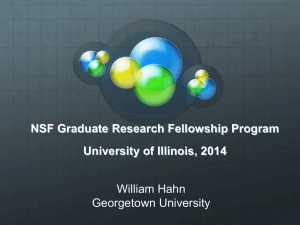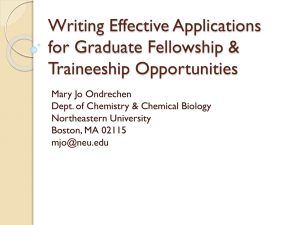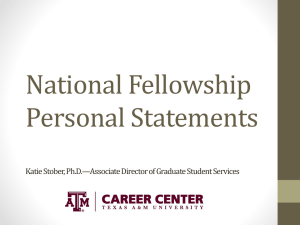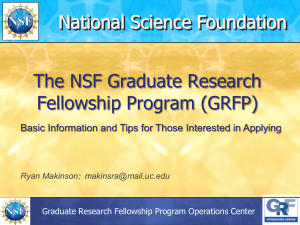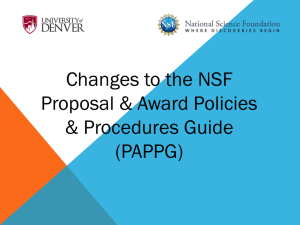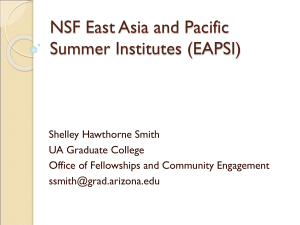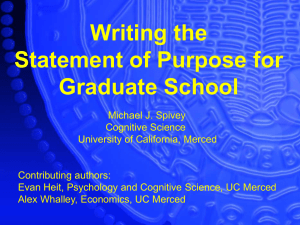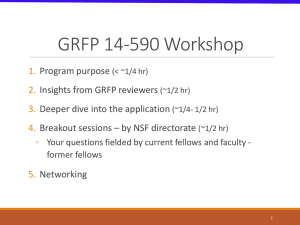Applying for the NSF Graduate Fellowship
advertisement
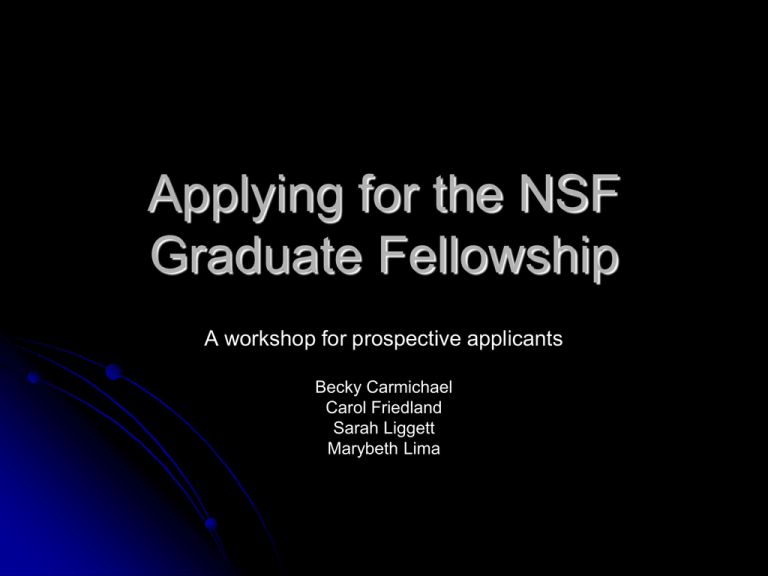
Applying for the NSF Graduate Fellowship A workshop for prospective applicants Becky Carmichael Carol Friedland Sarah Liggett Marybeth Lima Workshop overview Basic information on the Fellowship How the selection process works The ideal candidate for the NSF graduate Fellowship How to prepare the best application Panel discussion Written communication The reviewer’s perspective Basic information on the Fellowship Can be found at http://www.nsfgrfp.org/ Fellows receive Three years of support $32,000 annual stipend $12,000 cost-of-education allowance $1,000 one time international travel allowance TeraGrid Supercomputer access GROW (global research opportunities worldwide) initiative Basic information on the Fellowship Eligibility requirements Applicants must be United States citizens or nationals, or permanent resident aliens of the United States The term "national" designates a native resident of a commonwealth or territory of the United States, such as American Samoa, Guam, Puerto Rico, United States Virgin Islands, or the Northern Mariana Islands. It does not refer to a citizen of another country who has applied for United States citizenship. Eligibility Individuals are typically eligible to apply: During the senior year of college After graduating from college and prior to entering graduate school During the first year of graduate school Prior to completing the first term of the second year of graduate school. Applicants must have completed no more than 12 months of full-time graduate study or its equivalent as of August 1, 2013. Questions on eligibility: info@nsfgrfp.org Extenuating Circumstance Applicants who have completed more than twelve months of graduate study may be considered eligible if they have had an interruption in graduate study of at least two consecutive years prior to November 2013. To be eligible, applicants must have completed no additional graduate study by August 1, 2013. A statement describing the extenuating circumstance is required in the application. Basic information on the Fellowship: due dates All applications must be submitted through Fastlane by 7:00 CST on the following days: November 4, 2013 (Monday): Computer and Information Science and Engineering Engineering Materials Research Basic information on the Fellowship: due dates November 5, 2013 (Tuesday): Chemistry Mathematical Sciences Physics and Astronomy November 7, 2013 (Thursday): Psychology Social Sciences STEM Education and Learning Basic information on the Fellowship: due dates November 8, 2013 (Friday): Geosciences Life Sciences November 14, 2013 (Thursday) Reference letters for all fields of study Basic information on the Fellowship The application process involves Registering online in FastLane (NSF’s platform for electronic submission of your application) Having three people write letters of recommendation Writing two statements (essays): Personal Statement, Relevant Background and Future Goals Graduate Research Statement (proposed research) Statement requirements All statements should be written using standard 8.5" x 11" page size, 12-point, Times New Roman font or 12point, Computer Modern (LaTex) font, 1" margins on all sides, and must be single spaced or greater. Only citations and lists of publications and presentations may be a smaller font, no less than 10 point, Times New Roman or 10-point, Compuer Modern (LaTex). Small type size makes it difficult for reviewers to read the application; consequently, the use of small type not in compliance with the application guidelines may be grounds for NSF to return the application without review. Statement requirements 3-page limit for the Personal, Relevant Background and Future Goals Statement 2-page limit for the Graduate Research Statement References and citations are included in page limits. Statement requirements Character spacing should use normal (100%) single-line space option. Do not condense line spacing or reduce the character spacing scale. Adherence to type size, character spacing, and page length is necessary to ensure that no applicant will have an unfair advantage, by using smaller type or line spacing to provide more text in the application. Images may be included in your statements. However, they will be produced only in black and white. All images, footnotes, endnotes, and other citations are included in the page limit. How the selection process works After submission, your application will be reviewed by a panel of experts, usually professors in your field of study The panelists will review your application with respect two criteria: Intellectual merit Broader impacts The following elements should be considered in the review for both criteria: What is the potential for the proposed activity to Advance knowledge and understanding within its own field or across different fields (Intellectual Merit); Benefit society or advance desired societal outcomes (Broader Impacts)? To what extent do the proposed activities suggest and explore creative, original, or potentially transformative concepts? The following elements should be considered in the review for both criteria: Is the plan for carrying out the proposed activities wellreasoned, well-organized, and based on a sound rationale? Does the plan incorporate a mechanism to assess success? How well qualified is the individual, team, or organization to conduct the proposed activities? Are there adequate resources available to the PI (either at the home organization or through collaborations) to carry out the proposed activities? Broader impacts Broader impacts may be accomplished through the research itself through the activities that are directly related to specific research projects through activities that are supported by, but are complementary to, the project. NSF values the advancement of scientific knowledge and activities that contribute to achieving societally relevant outcomes. Such outcomes include, but are not limited to: full participation of women, persons with disabilities, and underrepresented minorities in science, technology, engineering, and mathematics (STEM); improved STEM education and educator development at any level increased public scientific literacy and public engagement with science and technology improved well-being of individuals in society Such outcomes include, but are not limited to: development of a diverse, globally competitive STEM workforce increased partnerships between academia, industry, and others improved national security increased economic competitiveness of the US and enhanced infrastructure for research and education. To evaluate the intellectual merit criterion, panelists will consider: The potential of the applicant to advance knowledge based on a holistic analysis of the complete application, including The personal, relevant background, future goals statement Graduate research statement, Strength of the academic record, Publication/presentations References. Panelists will not consider the GRE score! To evaluate the broader impacts criterion, panelists will consider: the potential of the applicant for future broader impacts as indicated by personal experiences, professional experiences, educational experiences and future plans How the selection process works After review, applicants are placed in groups indicating their likelihood of being funded NSF makes final award selections Awards are announced in the spring (April) The ideal candidate for the NSF graduate Fellowship I have taught 19 NSF graduate fellows from LSU Undergraduate GPAs ranged from 3.1 to 4.0 Most completed undergraduate research All had some form of extracurricular activity All worked very hard on their applications At least 6 drafts of each essay was common Several students were funded the second or third time they applied (use the reviewer comments to improve your next application) The ideal candidate for the NSF graduate Fellowship Is a Renaissance scholar Has fully addressed intellectual merit and broader impacts criteria in their application Is a reflective practitioner or scholar Everyone applying has good grades and excellent personal character; you must set yourself apart from the other applicants On being a reflective practitioner We tend to focus on the what (concrete experience) Go beyond “the what” in both your statements Answer: What, so what, now what? What: “I did research on…” So what: “Through my experience, I learned…” Now what: “My philosophy is…” Reflective practitioner, research What: The objectives of this project are So what: The anticipated results of this study relate to my hypothesis in the following ways: In the proposed project, I anticipate problems with xxx. If I encounter these problems, I will do y and z. Now what: The implication of this study is… How to prepare the best application (in my opinion) Start NOW Choose your recommendation letter writers very carefully Provide a full resume, copies of your essays, etc. Make sure that the reference knows you well enough to write a strong recommendation Help your references help you The reference letter 2 –page limit Address the NSF Merit Review Criteria of Intellectual Merit and Broader Impacts Explain nature of the relationship to the applicant Assess applicant's potential for contributing to a globally-engaged United States STEM workforce Evaluate applicant's academic potential and prior research experiences Evaluate applicant's proposed research Guidelines to share with your recommenders How to prepare the best application (in my opinion) The graduate research essay (proposed research) is the most important: focus on intellectual merit You are trying to prove that you know how to do research! This statement should be on a research project that you come up with yourself (make clear in essay) You will provide introduction/background information, a testable hypothesis, materials and methods for testing your hypothesis, and expected research results (plus any references you cite) How to prepare the best application (in my opinion) The most common mistake in the proposed research essay: Skipping over or glossing over expected results In research, results are the name of the game, so make sure that you focus on this portion of the essay My advice: be a reflective practitioner! Can you take your expected results a step further? How do the expected results tie back to your objectives or hypothesis? Research seldom works the way we planned; in which part of your study do you think results will be the most difficult to obtain? Why? How might you overcome this difficulty? What is the overall implication of your expected results? Personal Statement, Relevant Background & Future Goals Statement Gather your “data” Before starting the essay, write out answers to these questions: Why are you fascinated by your research area? What examples of leadership skills and unique characteristics do you bring to your chosen field? What personal and individual strengths make you a qualified applicant? How will receiving the fellowship contribute to your career goals? Gather your data What are all of your applicable (research) experiences? For each experience, what were the key questions, methodology, findings, and conclusions? Did you work in a team and/or independently? How did you assist in the analysis of results? How did your activities address the Intellectual Merit and Broader Impacts criteria? Analyze, interpret your “data” It’s not enough for a statement to relate personal information about your background or future goals. You need to interpret what the facts says about you. If you’re having trouble, consider these traits called “Habits of Mind.”* How does your narrative reflect one or more of them? Your readers are likely to recognize them as key intellectual and practical characteristics of a successful researcher. Persistence Curiosity Ability to collaborate Responsible risk taking Problem-solving abilities Ability to draw connections Openness Responsibility Flexibility Engagement Metacognition Creativity *From “Framework for Success in Postsecondary Writing,” a publication of NCTE and WPA. How to prepare the best application (in my opinion) Personal, Relevant Background and Future Goals Statement Share your personal character and experiences in the context of your passion to do research Don’t just talk about what you have done--be a reflective practitioner Philosophy? Impact on science, the public, society, culture? If you have not completed a formal undergraduate research experience, you must frame your prior work in terms of discovery; prove that you know how to do research through your experiences How to prepare the best application (in my opinion) For both essays Don’t just draw the dots with your words, connect them also (nuance is a lost art) The intellectual merit of this proposed research is… The broader impacts of this research are… Don’t overdo it—but at the same time, you want your reviewers to think that you can change the world How to prepare the best application (in my opinion) Enlist the assistance of a mentor(s) who will critique your essays Your research mentor and/or one of your references Honors Students: Dr. Drew Arms LA-STEM students: Dr. Isiah Warner or Ms. Melissa Crawford Joe Givens, McNairs Scholars Science students: Dr. Becky Carmichael, Studio 151 in Coates, click here to make an appointment Self-critique as if you were a reviewer; also give to a friend to review How to prepare the best application (in my opinion) Use all the space allotted to you for each essay Fitting your essays into two or three pages should be agonizing Multiple drafts are recommended Co-authorship on a refereed journal article is a real “feather in your cap” Panel discussion: Writing Resources Guide to Proposal Writing from the NSF Guide to Proposal Writing for the NSF—SUNY Guidelines to share with your recommenders General writing advice, see especially writing for the sciences Advice on writing personal statements--Purdue OWL CxC Studio 151 Panel discussion Comments from NSF proposal reviewers Questions or comments? You will sign up for workshop 2 online (we will email you a link around October 2) Don’t forget to bring 2 copies of your statements for critique during our next workshop Monday, October 21, Room 143 Coates Hall, 4:30-6:00 pm


